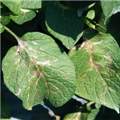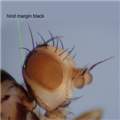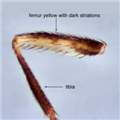
damage on potato (P. Ridland)

hind margin of eye black (A. Ames)

femur yellow with dark striations (A. Ames)

aedeagus (A. Ames)
Nomenclature
Liriomyza huidobrensis (Blanchard 1926)
Agromyza huidobrensis Blanchard 1926Liriomyza cucumifoliae Blanchard 1938Liriomyza langei Frick 1951Liriomyza decora Blanchard 1954Liriomyza dianthi Frick 1958
Common names: serpentine leafminer, pea leafminer, South American leafminer, potato leafminer fly
Hosts
Liriomyza huidobrensis is highly polyphagous and has been recorded worldwide from 365 host plant species in 49 plant families (Weintraub et al. 2017). The most important crops attacked include beans, peas, beet, spinach, potatoes, tomatoes and cut flowers (including gypsophila, carnations and chrysanthemum) (Spencer 1989).
Distribution
Africa: Comoros, Kenya, Mauritius, Morocco, Réunion, Seychelles, South Africa
Asia: China, India, Indonesia, Israel, Jordan,Lebanon, Malaysia, North Korea, Philippines, Singapore, South Korea, Sri Lanka, Syrian Arab Republic, Taiwan, Thailand, Vietnam
Central America: Belize, Costa Rica, Dominican Republic, El Salvador, Guadeloupe, Guatemala, Honduras, Nicaragua, Panama
Europe: Austria, Belgium, Bulgaria, Croatia, Cyprus, Czech Republic, Finland, France, Germany, Greece, Hungary, Italy, Malta, Netherlands, Norway, Poland, Portugal, Spain, Switzerland, Turkey, United Kingdom (incursions eradicated)
North America: Canada, mainland USA (Liriomyza langei)
Oceania: Australia (New South Wales 2020; Queensland 2020), Guam, Hawaii (Liriomyza langei)
South America: Argentina, Brazil, Chile, Colombia, Ecuador, French Guiana, Peru, Uruguay, Venezuela
Based on data from CABI Invasive Species Compendium (2019)
Key characters
Head with frons yellow, hind margin of eye largely black, third antennal segment enlarged, brownish yellow or at least somewhat brownish towards apex, mesonotum black and matt, scutellum bright yellow, femora yellow with brownish striations. Wing with last section of CuA1 2-2.5 times length of penultimate section, wing length 1.7-2.25 mm. Aedeagus: distiphallus with two distal bulbs, meeting only at their rims. Larva with posterior spiracles each with an ellipse of 6 to 8 pores. Key diagnostic features are shown in the PaDIL diagnostic images (Malipatil 2007).
Liriomyza huidobrensis is very similar to L. bryoniae and L. strigata (Dempewolf 2004; EPPO 2005; Shiao 2004). There are now robust molecular diagnostic tests to distinguish between the major polyphagous Liriomyza spp. including L. bryoniae (Kox et al. 2005; Masetti et al. 2006; Nakamura et al. 2013; Sooda et al. 2017). Molecular Diagnostics
Notes
Since the early 1990s, there has been a rapid movement of L. huidobrensis and L. sativae eastward through tropical and sub-tropical areas of Asia, resulting in much crop loss and excessive use of broad-spectrum insecticides (Rauf et al. 2000). Liriomyza huidobrensis is the dominant agromyzid at higher elevations (>1000 m asl) in tropical Asia and has caused much damage to potato in particular (Rauf et al. 2000; Shepard et al. 1998; Sivapragasam & Syed 1999; Spencer 1989; Tantowijoyo & Hoffmann 2010) while L. sativae is the dominant pest in lowland areas (Andersen et al. 2002; Rauf et al. 2000; Spencer 1989; Tantowijoyo & Hoffmann 2010). While L. huidobrensis has been recorded in Lombok on potatoes in 2005 (I Wayan Supartha, personal communication), its thermal biology and Asian and Central American experiences (Rodríguez-Castañeda et al. 2017) suggest that L. huidobrensis is less likely than L. sativae to establish in northern Australian horticultural areas (apart from the Atherton Tablelands). Conversely, L. huidobrensis will be better suited than L. sativae to the more temperate horticultural areas.
In June 2020, the Australian Department of Agriculture, Water and the Environment suspended the systems approach and alternative NPPO approved disinfestation treatment measures for chrysanthemum cut flowers from Malaysia due to repeated detections of Liriomyza huidobrensis. https://www.agriculture.gov.au/import/industry-advice/2020/102-2020. In Australia, Liriomyza huidobrensis was initially detected in western Sydney in October, 2020 and it has now been also recorded in southern Queensland (AusVeg 2020, DPI NSW 2020).
The biology and ecology of polyphagous Liriomyza spp. (including L. huidobrensis) have been reviewed by Murphy & LaSalle (1999), Parrella (1982, 1987), Reitz et al. (2013) and Waterhouse & Norris (1987). In recent years, there has been much additional research conducted on L. huidobrensis in South America, Europe and Asian countries on aspects of its biology (Lanzoni et al. 2002; Martin et al. 2005; Videla et al. 2006), climatic modelling (Milla & Reitz 2005), ecology (Chen & Kang 2004; Weintraub 2001), host plant resistance (Videla & Valladares 2007), insecticidal control (Hidrayani et al. 2005; Prijono et al. 2004) and natural enemies (Fisher et al. 2005). The importance of Liriomyza huidobrensis as a worldwide pest is demonstrated in the comprehensive review by Weintraub et al. (2017). A summary of the biology and diagnostic characteristics of L. huidobrensis are also given in the PaDIL fact sheet (Malipatil 2007).
The larva of L. huidobrensis forms an irregular serpentine mine tending to be restricted by veins within segments of the leaf and undulating between upper and lower leaf surface. On potatoes, the infested leaves and leaves senesce prematurely, up to 4 weeks early.
In southern Australia, common agromyzids such as L. chenopodii, L. brassicae and Chromatomyia syngenesiae (usually on Sonchus oleraceus) on weeds and other non-crop plants would act as important reservoirs for populations of parasitoids (e.g. Diglyphus isaea) of L. huidobrensis and other invasive polyphagous agromyzids (Bjorksten et al. 2005; Lardner 1991; Ridland et al.em> 2020).
Liriomyza huidobrensis is now considered a complex of two cryptic species (Scheffer 2000). This follows a study of specific sequences in mitochondrial and nuclear genomes (Scheffer 2000; Scheffer & Lewis 2001). The name Liriomyza langei has been applied to North American (USA & Hawaii) populations, and the name L. huidobrensis applied to Central and South American populations. All invasive populations in Africa, Asia, Canada and Europe were found to belong to L. huidobrensis as so defined (Scheffer et al. 2001). Liriomyza langei and L. huidobrensis could not be separated morphologically, but a PCR-RFLP protocol for separating them has been published (Scheffer et al. 2001). Consequently the literature from USA on L. huidobrensis should in fact be considered as L. langei.
References
Andersen A, Nordhus E, Thang VT, An TTT, Hung HQ & Hofsvang T (2002). Polyphagous Liriomyza species (Diptera: Agromyzidae) in vegetables in Vietnam. Tropical Agriculture (Trinidad) 79: 241-246.
AusVeg (2020). Serpentine leafminer detection in NSW and QLD https://ausveg.com.au/articles/serpentine-leafminer-detection-in-nsw-and-qld/
Bjorksten TA, Robinson M & La Salle J (2005). Species composition and population dynamics of leafmining flies and their parasitoids in Victoria. Australian Journal of Entomology 44: 186-191.
Blanchard EE (1926). A dipterous leaf-miner on Cineraria, new to science. Revista de la Sociedad Entomologica Argentina 1: 10-11. https://www.biotaxa.org/RSEA/article/view/63896
Blanchard EE (1938). Descripciones y anotaciones de dipteros argentinos Agromyzidae. Anales de la Sociedad Científica Argentina 126: 352-359.
Blanchard EE (1954). Sinopsis de los Agromizidos argentinos (Diptera: Agromyzidae). Ministerio de Agricultura y Ganaderia, Buenos Aires. Publication No. 56: 1-48.
CABI (2019). Liriomyza huidobrensis serpentine leafminer. In: Invasive Species Compendium. CAB International, Wallingford, UK. Available from URL: https://www.cabi.org/isc/datasheet/30956 [Accessed 15 February 2019].
Chen B & Kang L (2004). Variation in cold hardiness of Liriomyza huidobrensis (Diptera: Agromyzidae) along the latitudinal gradients. Environmental Entomology 33: 155-164.
Dempewolf M (2004). Arthropods of Economic Importance - Agromyzidae of the World (CD-ROM). ETI. University of Amsterdam, Amsterdam. https://agromyzidae.linnaeus.naturalis.nl/linnaeus_ng/app/views/species/nsr_taxon.php?id=57046&epi=55
DPI NSW (2020). https://www.dpi.nsw.gov.au/biosecurity/plant/insect-pests-and-plant-diseases/exotic-leaf-miners
EPPO (2005). Liriomyza spp. EPPO Bulletin 35: 335-344.
Fisher N, Ubaidillah R, Reina P & La Salle J (2005). Liriomyza Parasitoids in Southeast Asia. https://keys.lucidcentral.org/keys/v3/Liriomyza/index.html
Frick KE (1951). Liriomyza langei, a new species of leaf-miner of economic importance in California. Pan-Pacific Entomologist 21: 81.
Frick KE (1958). Liriomyza dianthi n. sp., a new pest of carnations in California. Proceedings of the Entomological Society of Washington 60: 1-5.
Hidrayani, Purnomo, Rauf A, Ridland PM & Hoffmann AA (2005). Pesticide applications on Java potato fields are ineffective in controlling leafminers, and have antagonistic effects on natural enemies of leafminers. International Journal of Pest Management 51: 181-187.
Kox LFF, van den Beld HE, Lindhout BL & de Goffau LJW (2005). Identification of economically important Liriomyza species by PCR-RFLP analysis. EPPO Bulletin 35: 79-85.
Lambkin CL, Fayed SA, Manchester C, La Salle J, Scheffer SJ & Yeates DK (2008). Plant hosts and parasitoid associations of leaf mining flies (Diptera: Agromyzidae) in the Canberra region of Australia. Australian Journal of Entomology 47: 13-19.
Lanzoni A, Bazzocchi GG, Burgio G & Fiacconi MR (2002). Comparative life history of Liriomyza trifolii and Liriomyza huidobrensis (Diptera: Agromyzidae) on beans: effect of temperature on development. Environmental Entomology 31: 797-803.
Lardner RM (1991). Comparative host stage utilization of two parasitoids of Liriomyza brassicae (Diptera: Agromyzidae). PhD Thesis, University of Adelaide. thesis details
Malipatil MB (2007). Pea leafminer (Liriomyza huidobrensis) Pest and Diseases Image Library. Updated on 11/07/2007 10:58:12 AM. Available online: http://www.padil.gov.au
Martin AD, Stanley-Horn D & Hallett RH (2005). Adult host preference and larval performance of Liriomyza huidobrensis (Diptera: Agromyzidae) on selected hosts. Environmental Entomology 34: 1170-1177.
Masetti A, Luchetti A, Mantovani B & Burgio G (2006). Polymerase chain reaction-restriction fragment length polymorphism assays to distinguish Liriomyza huidobrensis (Diptera: Agromyzidae) from associated species on lettuce cropping systems in Italy. Journal of Economic Entomology 99: 1268-1272.
Milla K & Reitz S (2005). Spatial/temporal model for survivability of pea leafminer (Liriomyza huidobrensis) in warm climates: a case study in south Florida, USA. European Journal of Scientific Research 7: 65-73.
Murphy S & La Salle J (1999). Balancing biological control strategies in the IPM of New World invasive Liriomyza leafminers in field vegetable crops. Biocontrol News and Information 20: 91N-104N.
Nakamura S, Masuda T, Mochizuk A, Konishi K, Tokumaru S, Ueno K & Yamaguchi T (2013). Primer design for identifying economically important Liriomyza species (Diptera: Agromyzidae) by multiplex PCR. Molecular Ecology Resources 13, 96-102.
Parrella MP (1982). A review of the history and taxonomy of economically important serpentine leafminers (Liriomyza spp.) in California (Diptera: Agromyzidae). Pan-Pacific Entomologist 58: 302-308.
Parrella MP (1987). Biology of Liriomyza. Annual Review of Entomology 32: 201-224.
Prijono D, Robinson M, Rauf A, Bjorksten T & Hoffmann AA (2004). Toxicity of chemicals commonly used in Indonesian vegetable crops to Liriomyza huidobrensis populations and the Indonesian parasitoids Hemiptarsenus varicornis, Opius sp., and Gronotoma micromorpha, as well as the Australian parasitoids Hemiptarsenus varicornis and Diglyphus isaea. Journal of Economic Entomology 97: 1191-1197.
Rauf A, Shepard BM, Johnson MW (2000). Leafminers in vegetables, ornamental plants and weeds in Indonesia: surveys of host crops, species composition and parasitoids. International Journal of Pest Management 46: 257-266.
Reitz SR, Gao Y & Lei Z (2013). Insecticide use and the ecology of invasive Liriomyza leafminer management Inem> Insecticides – Development of Safer and More Effective Technologies (ed. S Trdan). InTech, Rijeka, Croatia. https://www.intechopen.com/books/insecticides-development-of-safer-and-more-effective-technologies/insecticide-use-and-the-ecology-of-invasive-liriomyza-leafminer-management
Ridland PM, Umina PA, Pirtle EI & Hoffmann AA (2020). Potential for biological control of the vegetable leafminer, Liriomyza sativae (Diptera: Agromyzidae), in Australia with parasitoid wasps. Austral Entomology 59: 16-36. https://doi.org/10.1111/aen.12444
Rodríguez-Castañeda G, MacVean C, Cardona C & Hof AR (2017). What limits the distribution of Liriomyza huidobrensis and its congener Liriomyza sativae in their native niche: when temperature and competition affect species’ distribution range in Guatemala. Journal of Insect Science 17, 88 https://doi.org/10.1093/jisesa/iex059
Scheffer SJ (2000). Molecular evidence of cryptic species within the Liriomyza huidobrensis (Diptera: Agromyzidae). Journal of Economic Entomology 93: 1146-1151.
Scheffer SJ & Lewis ML (2001). Two nuclear genes confirm mitochondrial evidence of cryptic species within Liriomyza huidobrensis (Diptera: Agromyzidae). Annals of the Entomological Society of America 94: 648-653.
Scheffer SJ, Wijesekara A, Visser D & Hallett RH (2001). Polymerase chain reaction-restriction fragment-length polymorphism method to distinguish Liriomyza huidobrensis from L. langei (Diptera: Agromyzidae) applied to three recent leafminer invasions. Journal of Economic Entomology 94: 1177-1182.
Shiao SF (2004). Morphological diagnosis of six Liriomyza species (Diptera: Agromyzidae) of quarantine importance in Taiwan. Applied Entomology and Zoology 39: 27-39. abstract, pdf
Shepard BM, Samsudin & Braun A (1998). Seasonal incidence of Liriomyza huidobrensis (Diptera: Agromyzidae) and its parasitoids on vegetables in Indonesia. International Journal of Pest Management 44: 43-47.
Sivapragasam A & Syed AR (1999). The problem and management of agromyzid leafminers on vegetables in Malaysia. In Proceedings of a Workshop on Leafminers of Vegetables in Southeast Asia (eds Lim GS, Soetikno SS & Loke WH), Serdang, Malaysia, CAB International, Southeast Asia Regional Centre, pp. 36-41.
Sooda A, Gunawardana D, Li D & Kumarasinghe K (2017). Multiplex real-time PCR assay for the detection of three invasive leafminer species: Liriomyza huidobrensis, L. sativae and L. trifolii (Diptera: Agromyzidae). Austral Entomology 56, 153-159.
Spencer KA (1973). Agromyzidae (Diptera) of economic importance. Series Entomologica 9. Dr W Junk, The Hague. 418 pp.
Spencer KA (1989). Leaf miners. In Plant Protection and Quarantine, Vol. 2, Selected Pests and Pathogens of Quarantine Significance (ed. Kahn RP). CRC Press, Boca Raton, pp. 77-98.
Spencer KA (1990). Host specialization in the world Agromyzidae (Diptera). Series Entomologica 45. Kluwer Academic Publishers, Dordrecht. 444 pp.
Tantowijoyo W & Hoffmann AA (2010). Identifying factors determining the altitudinal distribution of the invasive pest leafminers Liriomyza huidobrensis and Liriomyza sativae. Entomologia Experimentalis Applicata 135: 141-153.
Videla M & Valladares G (2007). Induced resistance against leafminer eggs by extrusion in young potato plants. International Journal of Pest Management 53: 259-262.
Videla M, Valladares G & Salvo A (2006). A tritrophic analysis of host preference and performance in a polyphagous leafminer. Entomologia Experimentalis et Applicata 121: 105-114.
Waterhouse DF & Norris KR (1987). Biological control. Pacific prospects. ACIAR. Inkata Press Melbourne.
Weintraub PG (2001). Changes in the dynamics of the leafminer, Liriomyza huidobrensis, in Israeli potato fields. International Journal of Pest Management 47: 95-102.
Weintraub PG, Scheffer SJ, Visser D, Valladares G, Correa AS, Shepard BM, Rauf A, Murphy ST, Mujica N, MacVean C, Kroschel J, Kishinevsky M, Joshi RC, Johansen NS, Hallett RH, Civelek HS, Chen B & Metzler HB (2017). The invasive Liriomyza huidobrensis (Diptera: Agromyzidae): understanding its pest status and management globally. Journal of Insect Science 17(1), 28: 1-27. https://doi.org/10.1093/jisesa/iew121
WWW Resources
Liriomyza huidobrensis in Dempewolf M (2004). Arthropods of Economic Importance - Agromyzidae of the World
EPPO information on Liriomyza huidobrensis fact sheet, diagnostic protocol, images
Hort Innovation MT16004 RD&E Program for control, eradication and preparedness for Vegetable Leafminer 2017 – 2020 Project Outputs https://ausveg.com.au/biosecurity-agrichemical/biosecurity/mt16004/
IPPC (2016). ISPM 27 Diagnostic protocols for regulated pests. DP 16: Genus Liriomyza https://www.ippc.int/static/media/files/publication/en/2017/01/DP_16_2016_En_2017-01-30.pdf
PaDIL diagnostic images and fact sheet. Pea leafminer Liriomyza huidobrensis (Blanchard) (Diptera: Agromyzidae) Pest and Diseases Image Library. Updated on 11.vii.2007. http://www.padil.gov.au/pests-and-diseases/pest/main/136237
Liriomyza huidobrensis in Ellis WN (2018). Plant Parasites of Europe - leafminers, galls and fungi
Liriomyza huidobrensis in Pitkin B, Ellis W, Plant C & Edmunds (2008). The leaf and stem mines of British flies and other insects
Liriomyza huidobrensis in Martinez M (2007). Fauna Europaea: Agromyzidae. In Pape T (ed.) (2007) Fauna Europaea: Diptera: Brachycera. Version 1.3 [128143] <
Updated
2021-01-23




















